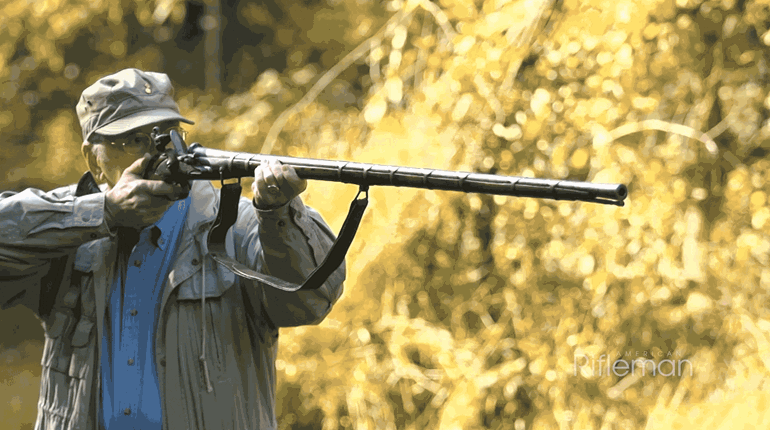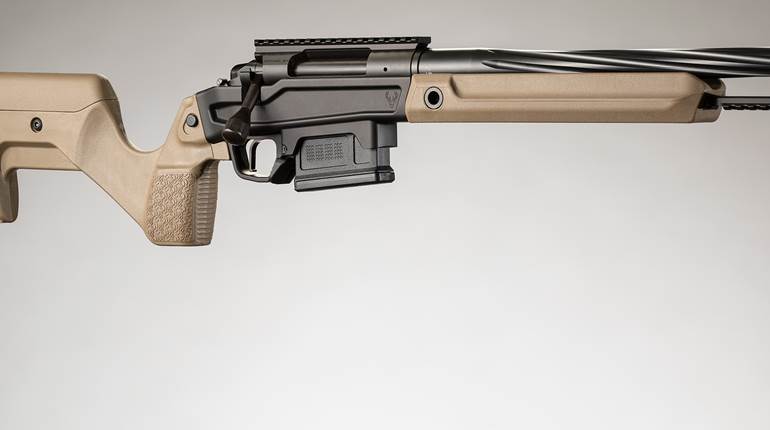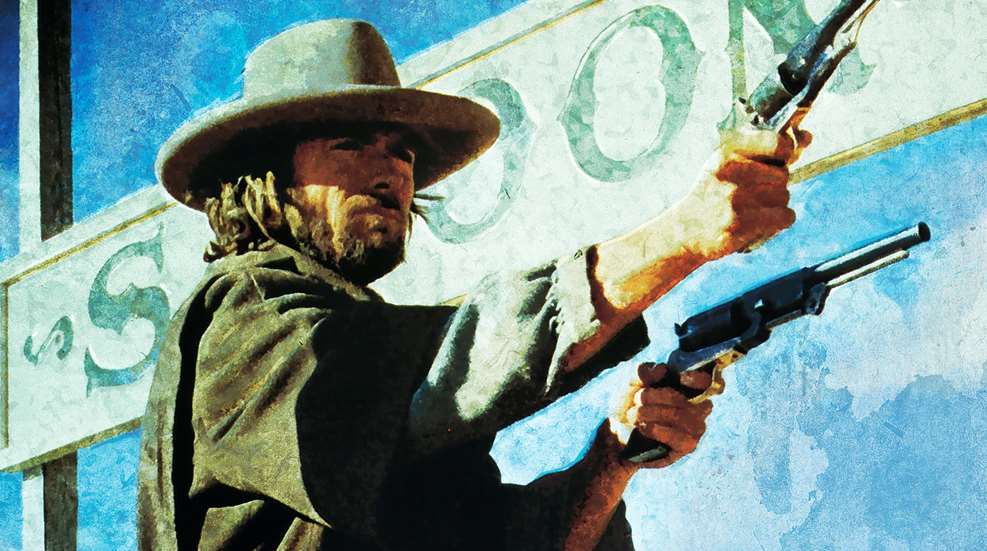
"Please boss, I only need one more day to really wrap things up. I promise I’ll be back in the office first thing on Wednesday with a ton more stuff for the exhibit."
My desperate plea was designed to buy some extra time at the southern California location so I could consolidate the exhibit artifacts that I had found just hours before in San Diego. “No,” was his stern reply. “You’ve been gone for a whole week, it’s time you got back here and did some work. I expect to see you bright and early Tuesday morning. Besides, you’ve promised Jim Baker to take some of the Parker collectors on a tour of the museum first thing Tuesday.” I agreed and hung up—just on this side of really mad.
Contrary to what my boss may have thought, I had been in Los Angeles for an entire week working on an exhibit that I thought would surely pack the house and create a great deal of buzz about our museum. True, I was hanging out with one of my closest friends the whole time, visiting Hollywood legends like Charlton Heston, John Milius and Tom Selleck and legendary producers like John Schofield—but it was all work. Well, for work, anyway. But let’s not kid ourselves, it was the best time of my life, and I couldn’t believe I was getting paid for doing it.
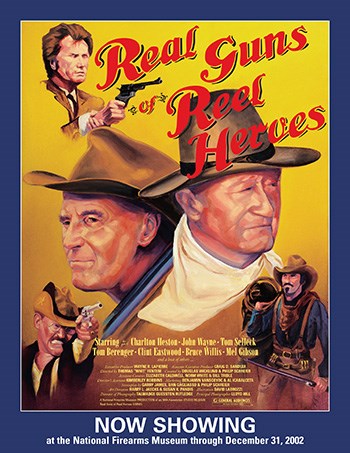 The exhibit that I was preparing was called “Real Guns Of Reel Heroes,” and it was an idea that I had come up with one evening after attending the grand opening of a World War I exhibit at the Smithsonian’s Air & Space Museum. At one end of the museum was our small party of World War I aviation geeks, and at the other end of the building were about 2,000 “Star Trek” fans heralding the opening of a new exhibit of props from a TV show that had only lasted three seasons on television. I was, at first, incredulous. In our exhibit, we had Gen. Billy Mitchell’s uniform, medals and boots, the only Sopwith Snipe biplane in America and one of the Red Baron’s victory cups. What did they have? A bunch of cobbled-together fantasy props and plastic models one generation removed from Ed Wood’s flying pie tins? Real history vs. sci-fi fantasy? How did they steal the march on us? Was popular culture really more interesting than real history? Evidently so, if the lines to get into that exhibit for the next few months were any indication. For the first time since the museum opened in 1976, it had to issue time-dated tickets for admission. So, I got to thinking—if you can’t beat ’em, join ’em.
The exhibit that I was preparing was called “Real Guns Of Reel Heroes,” and it was an idea that I had come up with one evening after attending the grand opening of a World War I exhibit at the Smithsonian’s Air & Space Museum. At one end of the museum was our small party of World War I aviation geeks, and at the other end of the building were about 2,000 “Star Trek” fans heralding the opening of a new exhibit of props from a TV show that had only lasted three seasons on television. I was, at first, incredulous. In our exhibit, we had Gen. Billy Mitchell’s uniform, medals and boots, the only Sopwith Snipe biplane in America and one of the Red Baron’s victory cups. What did they have? A bunch of cobbled-together fantasy props and plastic models one generation removed from Ed Wood’s flying pie tins? Real history vs. sci-fi fantasy? How did they steal the march on us? Was popular culture really more interesting than real history? Evidently so, if the lines to get into that exhibit for the next few months were any indication. For the first time since the museum opened in 1976, it had to issue time-dated tickets for admission. So, I got to thinking—if you can’t beat ’em, join ’em.
The first time I ever saw a gun was on television, and I had been smitten with them ever since. Watching Saturday morning shows like “Rat Patrol,” “Combat” and the dozens of Westerns that dominated the small screen was how I spent my youth. Why not mount an exhibit of television- and film-used firearms? I was sure that most of us reading American Rifleman magazine found our way to being members of the NRA by first being interested in the firearms that we saw being used on television. Sounded like a slam dunk to me, so I ran the idea past Whit Fentem, the director of the museum. He green-lit the proposal, and away we went.
Garry James was the first person I called to ask for help. He lived in Los Angeles and knew basically everyone there was to know in the film/gun world. Both of his parents had been actors, and as an editor at Guns & Ammo for 30 years, he had come to know just about anyone worth knowing in the Hollywood gun scene. The first stop we made was to Stembridge Gun Rentals in Glendale to meet Mike Papac of Cinema Weaponry. Mike is the dean of gun guys in Hollywood, and his collection has no peer. IMDb only lists about 10 percent of his real credits, but those in the know understand that Mike is the guy to call. We looked through the stacks and stacks of firearms in the warehouse. James Arness’ single-action from “Gunsmoke” was on the wall next to Dan Blocker’s from “Bonanza.” Syd Stembridge even had some of the balsa-wood gas grenades from the 1933 “King Kong” movie on top of a bookcase. For a gun/movie buff, this place was wonderland, and I couldn’t believe my good fortune at being there. Mike and Garry picked out some great guns for use in the exhibit: John Wayne’s large-loop Winchester 1892; Steve McQueen’s Sharps from “Nevada Smith;” Mel Gibson’s and Bruce Willis’ Beretta 92 used in “Lethal Weapon” and “Die Hard,” respectively (the same gun was used in both movies); as well as dozens of others that were just staggering to my imagination.
But the guns that truly caused goose bumps to overtake me were the repro Walker Colts used by Clint Eastwood in “The Outlaw Josey Wales” (1976). These really hit home with me, as I had been a Civil War buff since as early as I could remember. Watching Kurt Russell in “Mosby’s Marauders” in 1967 set the hook, after which I was keen to see any film or television show on the Civil War. The trouble was, there were not many Civil War films that were really any good. “The Horse Soldiers” (1959) was awesome, but it was a rarity in my desire to see a real epic. That soon changed when I was 13 years old. I saw ads for a new Clint Eastwood film that was hitting theaters that summer. There were clips of Civil War battles shown, and I just had to see the film. I was mesmerized by the massive Colt replica he brandished, and I had to know more about it. I saved up and then spent all my money on a book, Colt: An American Legend by R.L. Wilson, thus beginning my education.
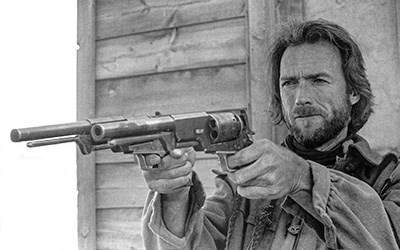 I learned that the massive 4-lb., 9-oz. revolver, a semblance of that which Clint Eastwood spun with such dexterity, was the idea of Samuel Hamilton Walker (1817-1847) of what is now Bowie, Md. He had been fighting the Seminole Indians in Florida when he met Samuel Colt (1814-1862), who introduced him to his patented five-shot revolver made in Paterson, N.J. Walker liked the repeating revolver that Colt sold him and took it to Texas with him when he joined the Texas Rangers. It was one of military history’s first “force multipliers,” as the Comanches that Walker encountered would soon find out. Walker’s Paterson Colts found favor with the Rangers, and many found their way into the saddle holsters of the men under John Coffee “Jack” Hays’ (1817-1883) Ranger Company.
I learned that the massive 4-lb., 9-oz. revolver, a semblance of that which Clint Eastwood spun with such dexterity, was the idea of Samuel Hamilton Walker (1817-1847) of what is now Bowie, Md. He had been fighting the Seminole Indians in Florida when he met Samuel Colt (1814-1862), who introduced him to his patented five-shot revolver made in Paterson, N.J. Walker liked the repeating revolver that Colt sold him and took it to Texas with him when he joined the Texas Rangers. It was one of military history’s first “force multipliers,” as the Comanches that Walker encountered would soon find out. Walker’s Paterson Colts found favor with the Rangers, and many found their way into the saddle holsters of the men under John Coffee “Jack” Hays’ (1817-1883) Ranger Company.
During the Mexican-American War (1846-1848), Sam Walker’s Texas Rangers were absorbed into the United States Army, christened “Mounted Rifles” by Zachary Taylor and then turned loose on Santa Anna’s “guerrillas” to bring the war to Santa Anna the same way he was fighting us. Along with the new commission, Walker was given a blank check to outfit and equip his men. He immediately sent off a letter to Col. Colt in Hartford, Conn., asking for 1,000 revolvers to be made at the earliest convenience. He suggested changes to the Paterson design by asking for a .44-cal., six-shot cylinder, a trigger guard, a blade front sight made of German silver and a loading apparatus mounted on the gun itself. Colt received the letter with great joy and relief. He had been out of the gun business since 1842 and was in a great deal of personal debt. He turned to his friend Eli Whitney, Jr., and proposed a deal where the revolvers would be made in Whitney’s shop in Whitneyville on machines producing identical parts and assembled together under the same roof. The deal was struck. Walker received his revolvers within six months, and the industrial revolution took firm hold as a result of his letter to a bankrupt former gunmaker.
The rest, as they say, is history.
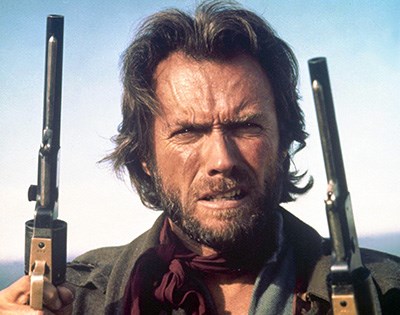 Walker was sent a pair of Model of 1847 revolvers as a personal gift from Colt, Serial Nos. 1009 and 1010 (See note, p. 47); he received them just prior to the Battle of Huamantla, Mexico, which took place on Oct. 9, 1847, where he was killed in action. He had famously used his two new Colts to set off abandoned Mexican cannons just prior to being fatally wounded. There were 1,000 Model 1847 (Walker) revolvers made for the U.S. Mounted Rifles and 100 made for civilian sales and gifts from Colt to those responsible for putting him back in business, making them the most prized and valuable of all Colt revolvers ever produced.
Walker was sent a pair of Model of 1847 revolvers as a personal gift from Colt, Serial Nos. 1009 and 1010 (See note, p. 47); he received them just prior to the Battle of Huamantla, Mexico, which took place on Oct. 9, 1847, where he was killed in action. He had famously used his two new Colts to set off abandoned Mexican cannons just prior to being fatally wounded. There were 1,000 Model 1847 (Walker) revolvers made for the U.S. Mounted Rifles and 100 made for civilian sales and gifts from Colt to those responsible for putting him back in business, making them the most prized and valuable of all Colt revolvers ever produced.
The more I read about the Walker Colts and the role they played in history, the more I was intrigued. The fact that Walker grew up just around the corner from me, the likelihood that some were still around 15 years after Walker died and saw use in the Civil War and the fact that Hollywood saw fit to make them the primary arm of “Josey Wales” was all, in my mind, just as it should have been. Too many movies erroneously show the Civil War being fought with 1873 Single Action Armys, and this was a film that seemed, to my 13-year-old mind, to be really authentic and showed off real percussion firearms, or at least so I thought at the time.
The film started shooting in the fall of 1975 and took eight weeks to complete, with locations in Arizona, Wyoming, Utah and northern California. The firearms used in it, Italian reproductions, were rented from Ellis Mercantile, a Hollywood prop house founded in 1908 that closed in 2001. The film’s property master, Edward (Eddie) Aiona (1931-2015), also served as the main armorer on the set. Aiona had worked with Eastwood on most of his films since “Magnum Force” (1973) and is thought to be the man responsible for choosing, along with Eastwood, the variety of historically authentic firearms used in most of his films, including “Unforgiven” (1992). Forrest Carter’s source novel The Rebel Outlaw, Josey Wales, copyright 1973, never mentions Model 1847 (Walker) Colts in the text. He does mention a “big .44” a few times and specifically mentions a Navy .36 kept in his shoulder holster under his arm (in the movie, it is a .31-cal. 1849 Pocket Colt in the shoulder holster), but the specific model of Colt is never actually mentioned.
To understand just how cool seeing a Walker Colt was on screen, you need to understand that there was only one depiction of a Walker in film prior to “Josey Wales” and that was in John Wayne’s 1969 classic “True Grit.”
Rooster Cogburn: Why, by God, girl, that’s a Colt’s Dragoon! You’re no bigger than a corn nubbin, what’re you doing with all this pistol?
Mattie Ross: It belonged to my father, he carried it bravely in the war, and I intend to kill Tom Chaney with it if the law fails to do so.
Rooster Cogburn: Well, this’ll sure get the job done if you can find a fence post to rest it on while you take aim.
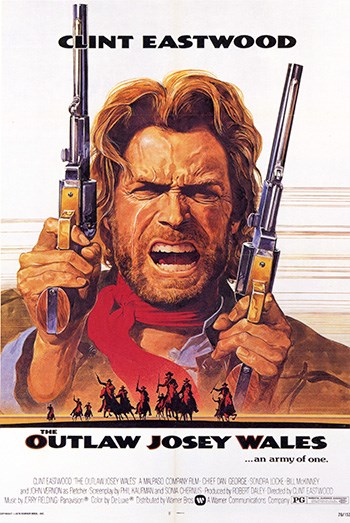 Sadly, the Duke mis-names the Walker that Kim Darby produces as a Dragoon, but the point was made. It was a big revolver. I suspect that Eastwood and Aiona also chose the Walker because it matched the description of “big” from the novel. The problem with choosing a unique revolver model for a film is that you need more than one of them on the set. Armorers are tasked with finding at least three identical copies of any prop gun so that there is a main (hero) gun and an heir and a spare in case one fails to fire. The idea is that a fresh gun can be immediately placed in the hands of the actor without causing any delays in filming the scene.
Sadly, the Duke mis-names the Walker that Kim Darby produces as a Dragoon, but the point was made. It was a big revolver. I suspect that Eastwood and Aiona also chose the Walker because it matched the description of “big” from the novel. The problem with choosing a unique revolver model for a film is that you need more than one of them on the set. Armorers are tasked with finding at least three identical copies of any prop gun so that there is a main (hero) gun and an heir and a spare in case one fails to fire. The idea is that a fresh gun can be immediately placed in the hands of the actor without causing any delays in filming the scene.
An issue with equipping Eastwood with Walker Colt reproductions was that Josey Wales had two of them, a pair of Model 1860 .44 Army Colts and one 1849 Pocket model. That required a number of guns to be ready on set at any given time. The Ellis Mercantile guns accounted for the majority, with Stembridge Gun Rentals providing additional Walkers to fill in. It is thought that there were no fewer than nine Walkers on the set during the course of the filming. Most of the guns had been converted from percussion to centerfire cartridge so that they would stand a better chance of not misfiring, as “5-in-1” Hollywood blanks were more reliable than the original percussion-cap Colts of the period.
There was at least one pair of “Walkers” in the original percussion-cap configuration used for close-up shots and publicity photos. These were originally owned by Ellis Mercantile but sold to Mike Papac’s Cinema Weaponry when Ellis held their auction in 2001. Stembridge Gun Rentals owned the “True Grit” Walker that was also rented out for Josey Wales. Robert E. Petersen purchased most of Stembridge’s inventory and sold off the bulk of it at a Little John Auction in Anaheim, Calif., in 2007. The National Firearms Museum acquired the “True Grit/Josey Wales” Walker after that sale.
One of Hollywood’s current master gunsmiths, Steve Karnes, converted two of the Ellis/Papac Walkers into cartridge-firing guns by fixing the percussion cap part of the cylinder to the recoil shield, cutting a hinged Single Action Army-style loading gate into the right side of the cylinder and altering the hammer to fire a centerfire cartridge. This was done post-Josey Wales, and this type of conversion was not used in the filming.
One of the mysteries to my 13-year-old mind was, “Just how did Eastwood manage to execute the ‘road-agent’s spin’ while in the outpost shack?” The road-agent’s spin is a revolver trick where the guns are offered butt-first to someone and then, in the flash of an eye, they are reversed and fired. I wore out my VHS tape by stopping and freezing the action, frame-by-frame, to see if I could discern the secret of the lightning-fast reversal. A Dixie Gun Works Uberti replica Walker was the second revolver I ever owned, and I set out to master the trick. On my second attempt, I started to practice over my bed and soon mastered it, but only with great difficulty. The gun weighed 4 lbs., 9 ozs., and Eastwood spun two of them simultaneously! I was (and still am) impressed.
The exhibit “Real Guns of Reel Heroes” needed more than Clint Eastwood’s Walkers to make it pop. Charlton Heston, Garry James, John Milius, Mike Papac, Tom Selleck, Phil Spangenberger and Karl Weschta at Independent Studio Services all contributed amazing items to the exhibit that have helped it to become one of the most popular the museum has ever mounted.
On my next-to-last day in Los Angeles, I went to the venerable Roosevelt Hotel for a movie memorabilia show to see what I might find in the way of black-and-white stills showing some of the artifacts actually in use. I met a vendor who had some neat stuff and invited me to San Diego to see his collection in hopes that I might add some more items to the display. He had a huge collection of props. One 55-gallon barrel held dozens of rubber guns used in hundreds of films. I dug and dug hoping to find something amazing and turned up a pair of Walker Colts. So exacting were the rubber copies that the Italian proofmarks, barrel address and serial number, 954, were all clearly discernible. I purchased them and headed north to Los Angeles after I called my boss to see if I could spend one extra day boxing up all the items that I had found in San Diego. His reply meant that I had to drive through the evening and spend the night in the Hertz parking lot so I could make my early flight home.
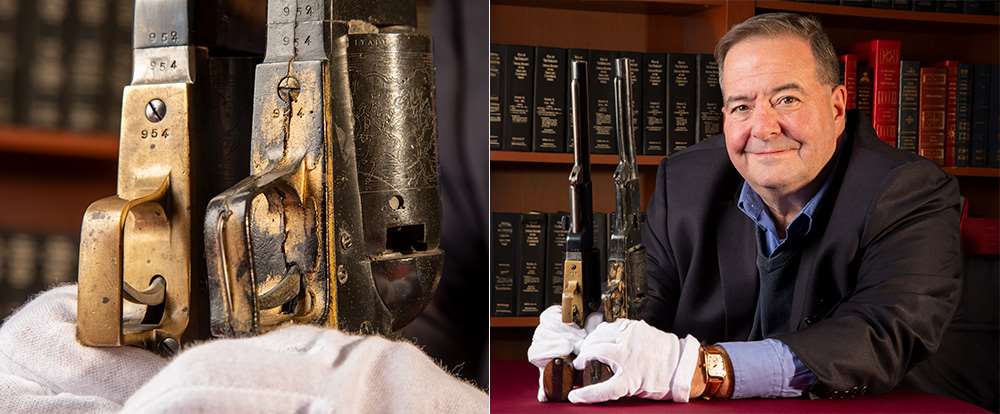
The next morning, I asked a Red Cap at the curb to help me with checking my luggage, which was now overburdened with the two Walkers, Clint Eastwood’s web gear from “Heartbreak Ridge” (1986), complete with rubber grenades, big rubber Bowie knives from “Young Guns” (1988) and a host of other lethal-looking impedimenta. He told me I was 20 lbs. overweight. I replied it was more like I was 100 lbs. overweight. He chuckled and offered to provide me with an extra box. We emptied the extraneous weaponry and accoutrements into the new box right at the curb at LAX. Anywhere else in the country someone might have called an air marshal, but heck, this was Hollywood.
It was on the plane ride home that I thought a lot about the rubber Walkers. What if Eastwood used the rubber guns to pull off the road-agent’s spin? I called Papac the minute I got home and asked the question. He laughed and said, of course, he used the rubber ones for the scene in the shack. How else could anyone aside from Arnold Schwarzenegger actually pull that off? He suggested I check the serial numbers on the guns he loaned me and the rubber ones I had picked up in San Diego. That was the first thing I did when I got to the office the next day, and the number matched Mike’s gun. I was ecstatic. A few years later, Mike found some photos taken during a photo session with Bill Gold (1921-2018), an artist who had been turning out some of the most memorable movie posters since “Casablanca” in 1942. He had joined Eastwood’s stock company after he did the poster for “Magnum Force” in 1973 and designed most of his posters through “J. Edgar” (2011). The photos were black-and-whites of Clint in the costume of “Josey Wales,” posing in a number of positions and facial gestures. One of the poses became the iconic enraged Wales that was used on the poster. The serial number of the gun is not present on the poster, but it is clear as a bell in the photo. Serial No. 954. For a museum curator, the provenance can’t get much better.
I waited until after the scheduled tour with the Parker collectors to tell my boss, Whit, my good news. As I approached his office, I could tell by the look on his face that I was in serious trouble for some reason. After all, I had heeded his orders in returning home at the scheduled time. What could be wrong? He told me it was a good thing I wasn’t still in Los Angeles, or I might never had gotten home. Terrorists had destroyed the World Trade Center towers in New York City and damaged the Pentagon, some 20 miles away from the museum, in the time it had taken me to show off the Parker Invincibles.
The real world was on the precipice of becoming a very different place.
Note: Colt’s Walkers Nos. 1009 and 1010 were recipients of NRA National Treasure Gold Medal number two in 1998 when they were owned by the late Dr. Joseph A. Murphy. They are now in a private collection and considered the most historically significant and valuable revolvers in the world.
Today, the ever-evolving exhibit “Hollywood Guns” is still the most popular attraction at the National Firearms Museum at NRA Headquarters in Fairfax, Va., and new guns are regularly added and replaced. The museum is open seven days a week from 9 a.m. to 4 p.m.



























